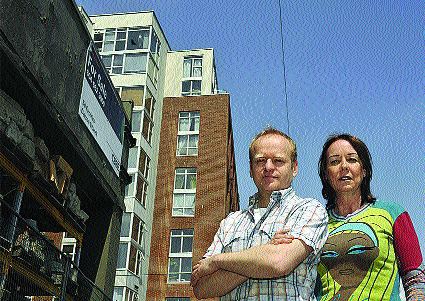There are few dishes you can cook that will not benefit from a splash of the grape, local chefs
Mia Stainsby
Sun

Cioppino’s Pino Posteraro prepares lobster linguine, which is one of Vancouver Canucks goalie Roberto Luongo’s favourite meals. Photograph by: Ian Smith, Vancouver
Does lobster linguine figure in the Canucks’ recent boot from the playoffs? It was goalie Roberto Luongo’s pre-home-game ritual meal; he would pick it up from Cioppino’s restaurant the day before home games.
As we know, hockey’s full of superstitious dos and don’ts and so it couldn’t have been good when the Canucks’ nemesis, the Chicago Blackhawks — the whole darn team — ate at Cioppino’s, some of them moving in on Luongo’s lobster linguine. Their goalie Nikolai Khabibulin went back three times to eat there.
“Roberto called me and said ‘What are you doing!'” says chef-owner Pino Posteraro, after one of the Canucks’ losing games.
Like most of Posteraro’s dishes, the lobster linguine is made all the more elixir-like with the magic of wine — in this case, the lobster is cooked in a court bouillon flavoured with wine and more wine in the pasta sauce.
“I use white wine for fish dishes. It cuts down the fat and it’s another layer of flavour,” says Posteraro, who can only catch glimpses of games while running the kitchen.
When it comes to cooking with wine, one common technique Posteraro avoids is marinating meats in wine to tenderize them because he thinks it does the opposite. “I just use a little more wine in the braising and cooking, reducing it to concentrate the flavour. You get the same results as marinating,” he says. “When you marinate, there is a loss of meat juices because of osmosis.”
And he never marinates game in wine because it intensifies the gaminess. “When I worked with a two-star Michelin chef, he told me never to marinate game; it gets a stronger flavour of game and gets drier.”
On the other hand, Jean-Francis Quaglia of Provence restaurants follows Provençal tradition, marinating his daube de boeuf in a wine-marinade overnight before cooking. “For me, marinating meat in red wine gives it such intense flavour,” he says. All his meat and poultry uses wine at some point in the cooking, he says.
Flavour-wise, from a scientist’s point of view, alcohol in wine reacts with acids in foods to form esters, which are fragrant and fruity. It can also react with oxidizing substances to form aldehydes, which are defining flavours in almond, cinnamon and vanilla.
But from a chef’s point of view, it simply adds an important dimension to the baseline. “It provides a foundation flavour,” says Warren Geraghty, chef at West. “It’s a very important flavour. It adds a rich, unctuous, fuller-bodied finish.”
But cooks should not attempt to show off their wine prowess by cooking with a $100 bottle of wine, he says. “Absolutely not. You’re reducing. You’re adding extreme heat. Can you imagine the fear on a sommelier’s face if you even stored wine on top of a radiator? You don’t boil a $100 bottle of wine.” Geraghty uttered that last comment just as West wine director Owen Knowlton walked by him. Knowlton winced as if shot through the heart.
The subtle notes of a fine wine won’t survive the blast of heat. “You’re wasting someone’s hard work if you spend too much on wine for cooking. It’s about respect for the guy making the wine, too,” says Geraghty.
When Knowlton chooses wines for cooking at home, his sommelier instinct kicks in and he uses the same strategy as pairing wines with food. That includes matching food and wine regions because wines are often created to go with foods of the region — like Argentinian Malbecs and grilled beef.
A bouillabaisse broth invites rose wines; lamb sauce invites Rioja; salmon calls for B.C. pinot gris; B.C. spot prawns call for something like Joie rose with the strawberry and raspberry notes; a sauce to go with steak calls for full-bodied cabernets like Australian shiraz or Spanish tempranillo.
If you should be so lucky as to be cooking lobster tail, the sauce ought have chardonnay, but unoaked.
“You don’t want smoky oaky,” Knowlton says.
However, oak might be a good idea with smoky B.C. sablefish.
Fruity wines, like German Rieslings go well with shellfish like scallops and Dungeness crab. But broths for mussels and clams might be more happy (as clams?) with simple, aromatic wines like Spanish Rueda wines. Zinfandels should team up with braised meats. “It’s full, rich, juicy and not tannic.”
But rare, grilled steaks demand tannic reds, like the Malbec.
“It’s trendy but has good value and good structure,” says Knowlton. “That being said, softer tannins cook better. If it’s too tannic, it’s going to give an intense dry, puckery sensation.” That’s another reason not to show off with expensive wines. The lower-priced wines work better for cooking as they’re not too tannic.
Once cooked in a dish, the distinctive taste of individual wines will be cooked off (as well as most of the alcohol.) What remains is the style of wine.
It’s important, however, to use fresh, lively wine. “It’s the acidity. If it’s been open for a week or two, you wouldn’t drink it and shouldn’t cook with it.” In other words, that half-bottle of white that’s sat unnoticed in the fridge? Forget about it!
The thing is, Knowlton says, there aren’t a lot of bad wines out there these days. Spending $10 to $20 for a wine to cook with is fine, he says.
“It’s amazing now. People have dialled into making great wines. Only a few are terrible. Inexpensive wines can be fantastic.”
As for the matter of luck and the lobster linguine, Posteraro says both he and Luongo are Italian, therefore superstitious, and maybe the Blackhawks took away some of the positive energy.
“In the end, Roberto’s such a great goalie and great person, I just feel lucky he comes here.”
© Copyright (c) The Vancouver Su









